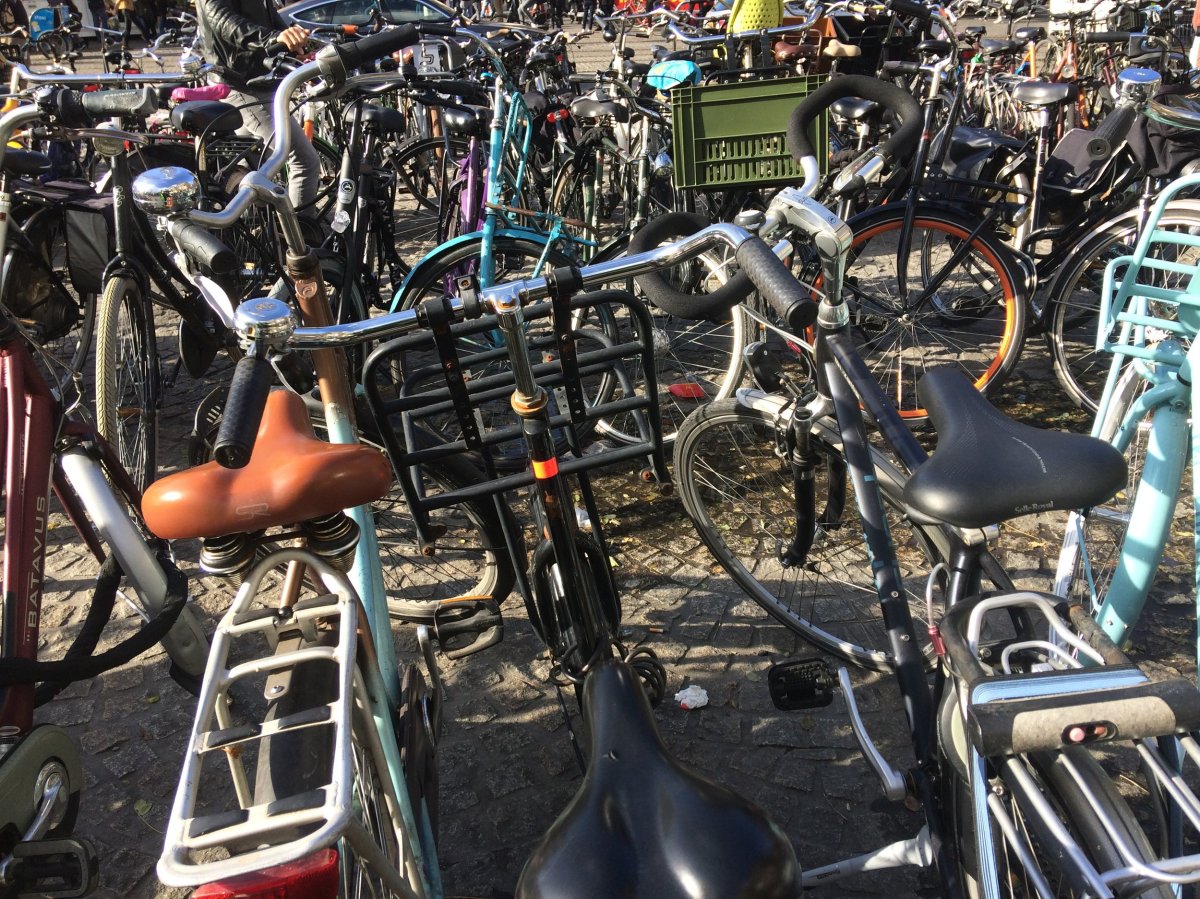The Dutch word omafiets translates to English as grandmother’s bike. A fietspad is a bikepath, a natural habitat of the omafiets.
You have to sit up straight when you’re riding an omafiets. The classic roadsters’ heavy black frame and wide comfortable seat demands good posture, and if you want to fit in, you ride the omafiets bare-headed. The Dutch do not wear helmets. I guess they missed the memo about concussion, they seem to prefer the wind running wild through their hair.
I have to admit it feels pretty good.
 Bikes populate an Amsterdam sidewalk. Everything you’ve heard about the Dutch and their bikes is probably true.
Bikes populate an Amsterdam sidewalk. Everything you’ve heard about the Dutch and their bikes is probably true.
The name omafiets suggests a lack of style, and I had to wonder, who would be caught dead on their grandmother’s bike? But they are not nearly as stodgy as their name implies. Equipped with back brakes, one speed, saddlebags and baskets, they embody a gracious classic style fused with function. You can look good on an omafiets while hauling your friends, your animals, or even small pieces of furniture, all while you bring home the groceries.
If you’re going to get an omafiets go for an old one. Flash new ones get stolen. While Holland generally has a low violent crime rate, it does have an omafiets theft problem. My bike’s rear tire involves a built in lock system, which activates with a key. I’ve been strongly advised to lock my bike whenever I’m not on it, anywhere, even in our own bike shed. Bike sheds are as ubiquitous as the omafiets, and while cars are left outside in all weather, the omafiets gets tucked in at night.
 It’s fuzzy because I was riding my bike at the time and everything was in motion. Also it was foggy. Look carefully: The boy is standing up behind his mother rushing to make first bell at school. The bike is standard bakfiets. The bak is the covered box in front.
It’s fuzzy because I was riding my bike at the time and everything was in motion. Also it was foggy. Look carefully: The boy is standing up behind his mother rushing to make first bell at school. The bike is standard bakfiets. The bak is the covered box in front.
If the omafiets has a partner, it is the opafiets, which translates as grandfather’s bike. The opafiets is distinguished by its crossbar. Both bikes work for individual transportation with goods, but if you need to move the kids as well, the Dutch have you covered. The bakfiets is specially designed to haul the kids around with a large front box-like compartment. A bak is a box. I have not ridden in the bakfiets, but my daughter has, and she tells me it’s terrifying due to its speed and close proximity to the ground.
 A high-end baksfiets three-seater. Note the headlight.
A high-end baksfiets three-seater. Note the headlight.
To my American eye the omafiets has an Oxbridge-ey, Brideshead Revisited sort of look. I half expect black-gowned undergraduates to swoop Harry Potter-like through the streets of our Dutch town, which my daughter says looks like a fairy tale village anyway, complete with thatched roofs and herringbone patterned brick pavement. The bricks are highly bike-able. If you see bricks, you have probably found a fietspad, and there are fietspads wherever there are roads.
I’ve been following the fietspad on my omafiets for two reasons.
Definitely because it’s fun, but also because I will bike a long mile to avoid driving here. I have managed to avoid driving overseas for many years, as it seemed all too frantic an exercise. But now I have had to step up to the plate and become a real euro-driver, which involves every man for himself as huge pan-continental trucks resist my attempts to merge onto highways, and cars speed through village streets too narrow and congested and completely full of bikes carrying denizens of all ages. Pizzas and the daily mail are delivered on bikes. There are babies and small dogs clinging to handle bars and kids riding pillion. Some bikes are motorized and some are actually Vespas. The Dutch are as home upon their bikes as they are in their living rooms.
The bikes have right of way, and they assert it boldly, so when driving the car my main goal is to not hit a bike. I count it a good driving day when I successfully navigate new roads and manage to park the car without having hurt anyone.
 The view from the seat of an omafiets.
The view from the seat of an omafiets.
I figure I am much better off on my trusty omafiets and I think I know why the Dutch are so devoted to theirs. A convenient way to traverse a flat country, ecologically sound and supported by a solid infrastructure of connected bike paths, designed to lend the slightest hint of glamour as they buzz along through the fresh air, the omafiets, opafiets and bakfiets are intrinsic parts of Dutch life. And the people riding them tend to be smiling.
The Dutch are having fun.
Mary Petiet is a reporter, writer and story teller. Her work is frequently inspired by her native Cape Cod, where she covers the local farm beat for Edible Cape Cod magazine. Mary is the author of Minerva’s Owls (Homebound Publications, April 2017), a book remembering the divine feminine to reenvision the world. She is currently dividing her time between Cape Cod and The Netherlands.


